What Is Matcha? A Guide to the Green Tea with Mizuba Tea Co.’s Lauren Purvis
Doesn’t it seem like ages ago that American culture, so naive and under-caffeinated, was swept away in a mad affair with espresso? In a matter of months, we went from spooning Folgers powder into our souvenir mugs or sipping day-old sludge from Styrofoam cups, to requesting “long shots” in our cortado and freaking out if our cappuccino had the wrong ratio of milk to foam.
Over the past couple of years, a similar revolution has been taking place with matcha, that pulverized tea with brilliant green color and vague reputation as a superfood. Once a novelty product that maybe only a few health nuts and Japanese ex-pats would recognize, matcha tea can now be found in Starbucks, smoothie shops, and grocery stores. Your girlfriend or sister is either a compete convert from coffee to matcha, or knows someone who is. Your mom orders it at the coffee shop when she’s feeling adventurous.
Matcha Benefits
In many ways, America’s move to matcha has a lot of advantages over the previous caffeinated revolution. While espresso gave us coffee house culture (and we thank it), matcha has a world of physical and mental health benefits that the coffee bean just can’t touch.

Before we get into the nitty-gritty, we put together a brief look at matcha.
- First things first: An 8-ounce cup of matcha actually contains more caffeine (70 mg) than a drink with a shot of espresso (64 mg). How do you like them apples, espresso?
- Matcha serves up this extra caffeine with a side order of L-theanine, an amino acid that promotes relaxation and calm. (It’s said that Zen monks used to drink matcha before marathon meditation sessions.) As a result, you get an energy boost without the jitters … or the crash when the caffeine wears off.
- Because matcha is made from the whole tea leaf (more on that below), it contains a lot of chlorophyll, which helps cleanse your blood and digestive tract. Side benefit: It neutralizes bad breath (left behind by, say, too much coffee)?
- We hear a lot about weight-loss teas, but matcha might actually be one. Studies have shown that regular matcha drinkers have 35-40% higher metabolic rates than non-matcha drinkers.
- The dietary fiber found in matcha can help prevent insulin spikes, slow down the development of type 1 diabetes and regulate glucose levels.
- Matcha is abundant with antioxidants that lower blood pressure, improve skin quality, and fight cardiovascular diseases and possibly even cancers.
What Is Matcha?
So much for the health benefits of matcha. What about the taste? It has a creamy, grassy taste that is faintly sweet and bitter in equal proportion. If you’re a food nerd, you’ll recognize this taste as the coveted “umami,” the rare fifth taste that comes from an ideal balance of the other taste sensations.
Matcha is also a great alternative to coffee in that it takes a lot less time to prepare. And we mean a lot less. Strangely, matcha preparation is often the biggest objection for both coffee and tea drinkers. Powdered tea, in and of itself, is a mental hurdle. Then there’s the exotic accouterments you often see paired with matcha — the little bamboo whisk, the frother, the special handle-less cups, the extra-long napkin (or is it a towel?), etc. What is all of that for, and is all of that essential to enjoying matcha?
Fair questions. Being new to the matcha scene ourselves, we spoke with Lauren Purvis, the enthusiastic expert behind Portland’s Mizuba Tea Co.
Let’s start at the beginning. How is matcha different from just green tea?
Lauren Purvis: We like to think of matcha as the Champagne of green tea. Akin to how Champagne is treated in France, matcha can only be truly considered “matcha” as opposed to “powdered green tea” if it comes from Japan. There are two reasons for this, looking at the historical journey of matcha and its terroir. Matcha is the only tea to be used in Japan’s iconic cha-no-yu (tea ceremony), so there is a long tradition of reverence around the tea. In turn, matcha is a highly specialized type of tea to grow. One can only taste the true character and revered flavor of matcha if it was grown in Japan — variables like the ideal climate for growing matcha, highly nutritious volcanic soil, and certain cultivars of the tea plant all play a part in matcha’s special, umami taste.
Matcha is one of the only teas that is powdered. Differing from regular green tea leaves, which are intended to be steeped, the leaves for matcha are shade-grown (which increases the nutrition content in the leaves) and subsequently stone-milled if it’s high quality. Quality mills will grind matcha to 1 micron. Therefore, instead of steeping leaves and throwing them away, when one drinks matcha, they drink 100% ground tea leaves!
Because matcha is a powdered green tea, the goal is to aerate the powder into a beautiful creamy froth either using a traditional whisk or shaking the powder.
TM: Walk us through the steps to prepare a perfect cup of matcha. What should people be looking for, in terms of taste, appearance, texture, etc.?
LP: Mizuba Tea Co’s perfect cup of matcha: A traditional preparation of matcha will involve two steps: koicha + usucha (thick tea, thin tea).
- Warm a chawan (tea bowl) with hot water. Discard water.
- Place 2.5 grams of Mizuba Matcha in your chawan (tea bowl) using your chashaku (tea scoop)
- Pour 1 ounce of 160 degrees Fahrenheit – 175 degrees F fresh water over your matcha tea. Using too-hot water will make your tea bitter. Do not use boiling water.
- Using your chasen (tea whisk) gently “knead” the tea in a circular motion so no clumps remain and a nice even paste forms. There should be a beautiful aroma. This is your koicha! In a traditional tea ceremony, you would sip this concentrated, intense tea followed by enjoying a wagashi (sweet treat).
- To enjoy the rest of your tea, make usucha. Pour 3-4 more ounces of warm water over your koicha tea. Use your chasen, make the characteristic “m” or zig-zag motion with the whisk by rapidly & lightly moving back and forth across the entire bowl until an even, creamy froth forms. Itadakimasu! Enjoy!
(You can see instructional videos here.)
TM: No offense, but that process sounds like a lot of work to do when you’re thirsty. Which parts of that are absolutely essential, and which are just nice to have?
LP: At Mizuba, we believe the best cup of tea is the one that you enjoy the most. So while we highly recommend our traditional tea tools, you are more than welcome to shake your matcha using a hearty cocktail-style shake in a mason jar or thermos (skipping the step of koicha) in a mason jar until frothy!
TM: Can you explain the differences between the various types of matcha? You offer quite a few at Mizuba — how are they different?
LP: Because we focus on artisanal matcha teas direct from small family farms, we are able to truly highlight special matcha teas that are difficult to find and highlight different flavor profiles. You can think of tasting our teas like tasting wine and finding the differences say, between a Syrah and a Pinot Noir.
Our base parameter is excellence, but the main difference between our teas are different cultivars, age of the tea plant, or harvest styles. Each variable will affect the flavor profile and how the tea tastes.
For example, we offer a delicious and mellow everyday drinker (our Daily Matcha) as well as a rare single-estate (our Yorokobi). We have a matcha tea that is harvested once a year from older, more mature plants on the farm (our Nagomi), which results in a uniquely nutty, very full-bodied and robust flavor. Our top-shelf matcha, our Kokoro, is harvested once a year by hand which yields an incredibly layered, naturally sweet matcha. It has been said the Mizuba Kokoro matcha “tastes like sipping true Japan!”
TM: Is it true that matcha is 137 times as powerful as regular tea?
LP: The 137 rumor is not true — this statement was actually misquoted from a study that was comparing matcha with Starbuck’s “China Green Tips” tea. Matcha certainly is good for you, but the rumor that it is 137 times more powerful in antioxidants is false — and that concentration would actually be dangerous to consume.
TM: How do you feel about the whole “matcha latte” craze? I’ve read that adding milk can mess up some of the beneficial compounds in matcha — any comment on that?
LP: As a specialty tea nerd, I could obviously go on about the purity of the leaf and the integrity of such a special tea but, I love matcha lattes! I love that lattes are a vehicle to allow so many people to try how delicious matcha is. And again — my motto is the best cup of tea is the one you enjoy the most.

While I drink my matcha 99% of the time plain, my family is deep in the coffee industry. My husband has worked in coffee for 10 years, and my family owns Good Coffee in Portland, Oregon. We love coffee shops and Mizuba currently works with 200+ specialty coffee shops nationwide. That being said, I always ensure if I’m drinking matcha lattes, the latte is made with quality matcha! You will taste a world of difference if your matcha latte made with quality tea and made properly.
It’s worth noting that Mizuba trains each of their 200 partner cafés in proper matcha preparation — 95% of them even use the traditional chasen whisk. Check out their locations on Mizuba’s website.
TM: Matcha also can be found in lots of desserts, and you offer culinary matcha as well. What kind of flavor does matcha add to sweets? What are some of your personal favorites?
LP: Love this question! Matcha adds such a dynamic, umami-filled depth to cooking. Cookies are pretty indisputable, but I also enjoy matcha in cocktails, hummus (yes, really! recipe on our website), easy DIY matcha ice cream (just throw a tablespoon of matcha with a pint of softened vanilla ice cream in your blender!) and…cookies. All the matcha cookies are fine by me.
TM: Tell us about how you got into matcha. What’s magical about it for you?
LP: I embarked on starting Mizuba matcha because tea was (and is) my lifelong passion! My family and friends encouraged me to pursue bringing quality tea to America after a trip where I was simply just visiting a friend in 2013. However, once there I met so many wonderful people in the tea industry just by happenstance and doing a deep dive into Japan’s tea culture — and the rest is history!
I am indebted to our tea producers in Japan. I continue to learn from them and am thankful for the opportunity they give me to share their work. Mizuba was built on relationships and I’m so thankful to be able to partner with the people we do in Japan that are working to preserve high-quality tea culture and heritage. We directly support, know, and trust our producers as our friends. The tea in itself is magic — but sharing a cup of tea with people you meet in life is the real magic!
Ready to experience the magic of matcha? Here are a few notes on what to look for, along with our special recommendations.
- Look for matcha that has been stone-ground and says “ceremonial grade” on the package. These indicate higher quality.
- Buy matcha that’s sold in a tin, as opposed to a plastic pouch or bag. Make sure the expiration date is at least six months out (preferably a year).
- Your matcha should be brilliant green in color when you open the tin. Any brownness in color is a sign of oxidization and/or low chlorophyll. The aroma can vary from grassy to nutty to toasty, but it should be abundant.
- Store your matcha in an opaque container in a cool place (like the fridge). Limit its exposure to light and heat until you’re ready to drink it. Make sure to consume it within a month.
Best Matcha

Daily Matcha
If you’re just getting acquainted with matcha, Mizuba’s Daily Matcha green tea is where you should start. Light and aromatic (pay attention and you’ll smell something like vanilla) with a luscious creamy mouthfeel, this matcha is shade-grown and stone-milled to order at their 100-year old family matcha manufactory in Uji, Japan. If you fall in love with it (and you will), you can sign up for a subscription order to ensure you never run out.
Matcha Chai
This preparation has definitely not been authorized by anybody in Japan’s matcha-growing prefecture. But that doesn’t mean it isn’t tasty. A mix of ceremonial-grade matcha, black tea, and warm spices, it blends together in a cup just as easily as standard matcha for a rich and bold taste with a healthy side of antioxidants.
Culinary Matcha
If you’re feeling audacious and want to try folding matcha into your favorite shortbread or cheesecake, select a culinary grade of matcha for the purpose. If you’re looking to impress your fellow diners, opt for Mizuba’s culinary matcha, whose lush, full-bodied flavor will definitely kick your dessert up a notch.
Matcha Preparation Set
If you want to get serious about matcha, or just want to get a present for someone who is, let Mizuba set you up. The matcha set includes a beautiful, traditional Chawan tea bowl, a 120-prong Chasen whisk, a tin of their signature House Organic Matcha tea, and a preparation card illustrating how to put it all together in the traditional Japanese Tea Ceremony style.
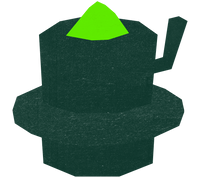

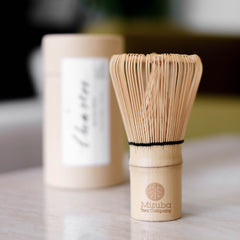
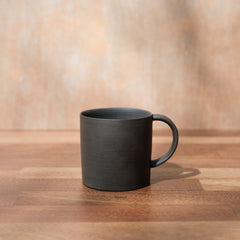
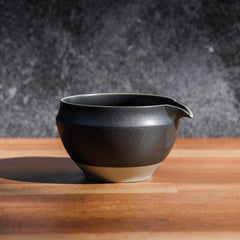
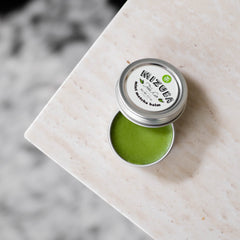
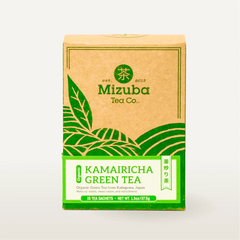

Leave a comment